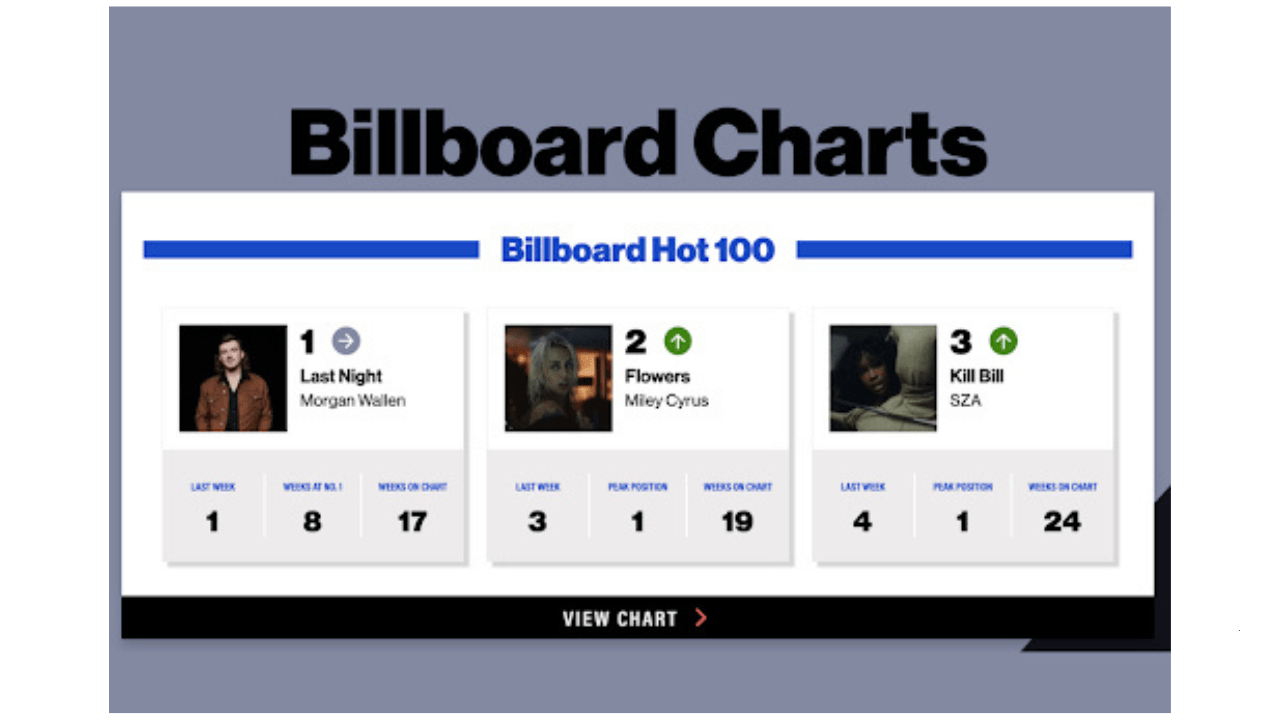The Billboard Chart is a ranking system that tracks the most popular songs, albums, and artists in the music industry. It serves as a barometer of success for musicians worldwide. If you’ve ever wondered how hits are measured or what defines a “chart-topper,” the Billboard Chart is the answer.
From pop anthems to hip-hop hits, this iconic chart captures the pulse of the music world. But what is the Billboard Chart exactly, and how does it work? Let’s dive into its history, purpose, and how it impacts the global music scene.
A Brief History of the Billboard Chart
The story of the Billboard Chart began in 1940 when Billboard Magazine introduced a ranking of popular songs. Over the decades, it evolved into a comprehensive charting system covering multiple genres and formats.
- The Early Days
Initially, the Billboard Chart relied on sheet music and jukebox play to rank songs. These methods reflected what people were listening to in public spaces. - The Digital Revolution
In the late 20th century, sales and radio airplay became key metrics. By the 2000s, digital downloads and streaming transformed the charting process.
Today, the Billboard Chart integrates various data sources to provide a holistic view of a song’s popularity.
How Does the Billboard Chart Work?
Understanding what the Billboard Chart is involves looking at its methodology. The chart is updated weekly and ranks songs and albums based on:
- Sales: Physical and digital copies sold.
- Streaming: Plays on platforms like Spotify, YouTube, and Apple Music.
- Airplay: The frequency of a song played on the radio.
Different charts focus on specific metrics. For instance, the Hot 100 ranks songs across all genres, while the Billboard 200 tracks the most popular albums.
Types of Billboard Charts
The Billboard Chart is not a single list but a collection of rankings. Each serves a unique purpose.
- Billboard Hot 100
This chart tracks the top 100 songs in the U.S. based on sales, streaming, and airplay. It’s the most recognized Billboard Chart. - Billboard 200
The Billboard 200 ranks the top albums each week. It considers sales and streaming equivalent albums (SEA). - Genre-Specific Charts
These charts focus on specific music styles like rock, hip-hop, country, and Latin. - Global Charts
In recent years, Billboard introduced global charts to reflect international music trends.
Why Is the Billboard Chart Important?
The Billboard Chart is more than just numbers. It influences careers, defines trends, and reflects cultural shifts.
- Artist Recognition
Charting on Billboard signals success. A high rank boosts an artist’s visibility and credibility. - Industry Trends
The chart shows what genres and styles dominate at any given time. - Cultural Impact
Songs on the Billboard Chart often become anthems of their era. They shape how people remember specific moments in time.
How Artists Make It to the Billboard Chart
To appear on the Billboard Chart, a song or album must perform well across the tracked metrics. Here are some strategies:
- Promote Streaming
Streaming is a key factor. Artists encourage fans to play their music repeatedly on platforms like Spotify. - Boost Sales
Digital and physical sales contribute significantly. Limited-edition releases often drive numbers. - Maximize Airplay
Radio remains a powerful tool. Many artists work with promoters to secure airplay. - Engage Fans
A loyal fanbase can drive a song’s success through coordinated streaming and purchasing efforts.
Criticisms of the Billboard Chart
While the Billboard Chart is a gold standard, it’s not without flaws. Critics argue that:
- Streaming Metrics Dominate: Some feel that streaming has overshadowed traditional metrics like sales.
- Manipulation: Allegations of chart manipulation through bulk purchases or streaming farms exist.
- Limited Representation: The chart sometimes focuses heavily on mainstream music, overlooking niche genres.
Despite these concerns, the Billboard Chart remains a trusted source for measuring musical success.
The Future of the Billboard Chart
As music consumption evolves, so does the Billboard Chart. Innovations like AI-driven data analysis and blockchain technology may shape its future.
- Increased Global Focus
With international artists like BTS and Bad Bunny dominating charts, Billboard’s global reach will likely expand. - New Metrics
Emerging platforms like TikTok are influencing music trends. Billboard may incorporate social media metrics into its calculations.
Final Thoughts
The Billboard Chart is a vital part of the music industry. It celebrates achievements, shapes careers, and connects fans with the latest hits. Whether you’re an artist aiming for the top or a fan tracking your favorite songs, understanding what the Billboard Chart is adds depth to your music experience.
Related Articles:
For further reading, explore these related articles:
- Global Music Charts: Trends, Insights, and Top Hits
- Physical Album Chart: A Deep Dive into Music Sales Rankings
For additional resources on music marketing and distribution, visit Deliver My Tune.






